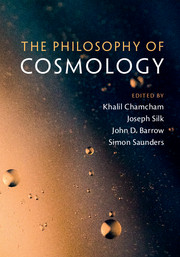Book contents
- Frontmatter
- Contents
- List of Contributors
- Preface
- Acknowledgments
- Part I Issues in the Philosophy of Cosmology
- Part II Structures in the Universe and the Structure of Modern Cosmology
- Part III Foundations of Cosmology: Gravity and the Quantum
- Part IV Quantum Foundations and Quantum Gravity
- 14 Is Time's Arrow Perspectival?
- 15 Relational Quantum Cosmology
- 16 Cosmological Ontology and Epistemology
- 17 Quantum Origin of Cosmological Structure and Dynamical Reduction Theories
- 18 Towards a Novel Approach to Semi-Classical Gravity
- Part V Methodological and Philosophical Issues
- Index
- References
18 - Towards a Novel Approach to Semi-Classical Gravity
from Part IV - Quantum Foundations and Quantum Gravity
Published online by Cambridge University Press: 18 April 2017
- Frontmatter
- Contents
- List of Contributors
- Preface
- Acknowledgments
- Part I Issues in the Philosophy of Cosmology
- Part II Structures in the Universe and the Structure of Modern Cosmology
- Part III Foundations of Cosmology: Gravity and the Quantum
- Part IV Quantum Foundations and Quantum Gravity
- 14 Is Time's Arrow Perspectival?
- 15 Relational Quantum Cosmology
- 16 Cosmological Ontology and Epistemology
- 17 Quantum Origin of Cosmological Structure and Dynamical Reduction Theories
- 18 Towards a Novel Approach to Semi-Classical Gravity
- Part V Methodological and Philosophical Issues
- Index
- References
Summary
Introduction
Quantum gravity is often considered to be the holy grail of theoretical physics. One approach is canonical quantum gravity, which concerns the Wheeler–DeWitt equation and which is obtained by applying the usual quantization methods (which were so successful in the case of high energy physics) to Einstein's field equations. However, this approach suffers from a host of problems, some of technical and some of conceptual nature (such as finding solutions to the Wheeler–DeWitt equation, the problem of time, …). For this reason one often resorts to a semi-classical approximation where gravity is treated classically and matter quantum mechanically [1, 2]. The hope is that such an approximation is easier to analyse and yet reveals some effects of quantum gravitational nature.
In the usual approach to semi-classical gravity, matter is described by quantum field theory on curved space-time. For example, in the case the matter is described by a quantized scalar field, the state vector can be considered to be a functional on the space of fields, which satisfies a particular Schrödinger equation
where the Hamiltonian operator depends on the space-time metric g. This metric satisfies Einstein's field equations
where the source term is given by the expectation value of the energy-momentum tensor operator.
This semi-classical approximation of course has limited validity. For example, it will form a good approximation when the matter state approximately corresponds to a classical state (i.e. a coherent state), but will fail to be so when the state is a macroscopic superposition of such states. Namely, for such a superposition we have so that the gravitational field is affected by two matter sources, one coming from each term in the superposition. However, one expects that according to a full theory for quantum gravity, the states each have their own gravitational field and that the total state is a superposition of those. And, indeed, Page and Geilker showed with an experiment that this semi-classical theory is not adequate [2, 3].
Of course, as already noted by Page and Geilker, it could be that this problem is not due to the fact that gravity is treated classically, but due to the choice of the version of quantum theory. Namely, Page and Geilker adopted the many worlds point of view, according to which the wave function never collapses.
- Type
- Chapter
- Information
- The Philosophy of Cosmology , pp. 356 - 374Publisher: Cambridge University PressPrint publication year: 2017
References
- 6
- Cited by



